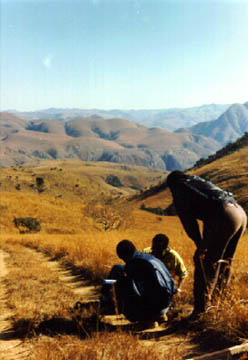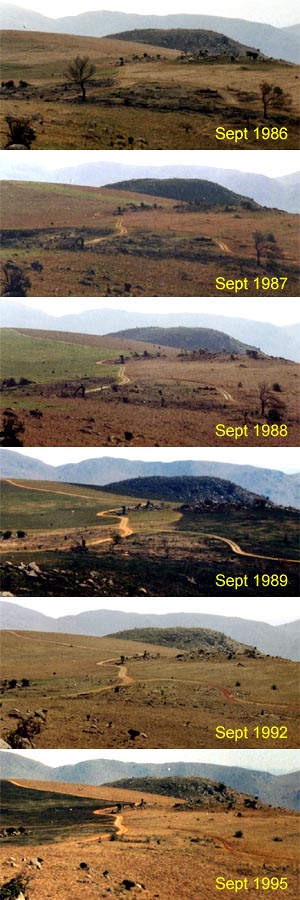PROGRAMMES: Malolotja Research
The research and monitoring programme is the cornerstone of the reserve's adaptive management system. Evaluation of information enables managers to determine the effects of management on the reserve environment and adjust management accordingly. Design and implementation of the monitoring programme is the responsibility of the Ecologist in discussion with the Senior Warden and Education Officer. Data collection has primarily been carried out by the SNTC ecologist, but assistance has been provided by the Senior Warden, Wardens and rangers. With the expansion on the monitoring programme to cover all aspects of reserve management, more data will be collected by the Wardens and senior education staff. The Ecologist provides a monitoring design, data analysis and reporting service to management and education staff.
The existing monitoring programme includes the following:
Fire:
Measuring the frequency, timing, extent and causes of all fires.
Climate:
Daily rainfall, screen temperature and humidity recordings.
Hydrology:
Stream flow and sediments loads of streams and rivers.
Soil erosion:
Monitoring of gully erosion, road and trail bed lowering, fixed point photographs of sheet eroded areas.

Erosion Monitoring
Flora:
Updating and revising the plant checklist, herbarium maintenance and distribution of rare or endangered species.
Vegetation monitoring:
Fixed point photographs to monitor changes.
Fixed Point Photo example:
This shows a portion of photographs taken from the same locality at the same time of year, over a number of years. This particular set of photos was taken partly to monitor the recovery of the vegetation after the clearing of an old established wattle forest.

Kniphofia umbrina:
Survey of natural and translocated populations. (See Hawane Research)
Fauna:
Updating and revising checklists of invertebrates, fish, amphibians, reptiles, birds, and mammals.
Large mammal populations:
Six monthly census in late April/early May and late October/early November (precise date weather dependent), distribution monitoring from ranger patrol data. This is carried out with assistance from the Natural History Society of Swaziland.
Priority species:
Nesting record survey for blue swallow and bald ibis.
Human impact:
Collation and analysis of visitor questionnaires, fixed point photographs are taken to monitor backpacking camps and other infrastructure.
Additional projects may be initiated as management practices change.
The following on-going projects are being carried out by All Out Africa in Malolotja Nature Reserve as part of All Out’s Transfrontier Conservation Project (www.alloutafrica.com/projects/transfrontier.aspx):
Ecosystem Monitoring:
- fixed point photography in Komati valley to monitor elephant impacts and alien species invasion
Threatened Species Monitoring:
- survival and reproduction of Encephalartos laevifolius and E. paucidentatus
- nesting and breeding success of blue swallow and bald ibis
- territorial activity of Aardwolves
- annual waterfowl census
- reptile atlassing

